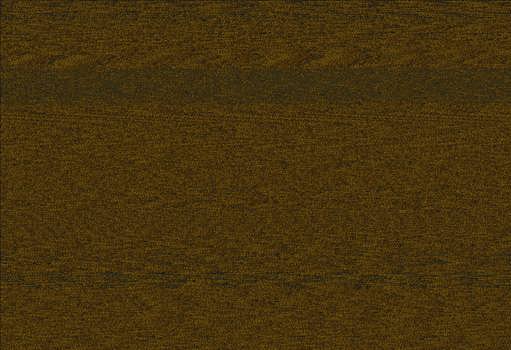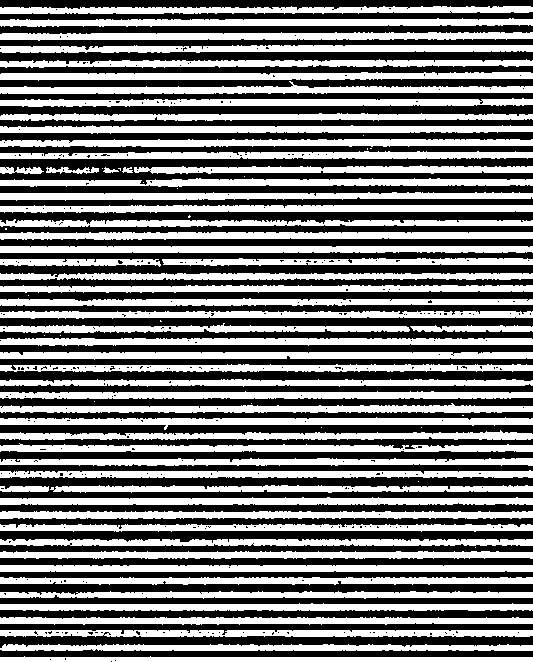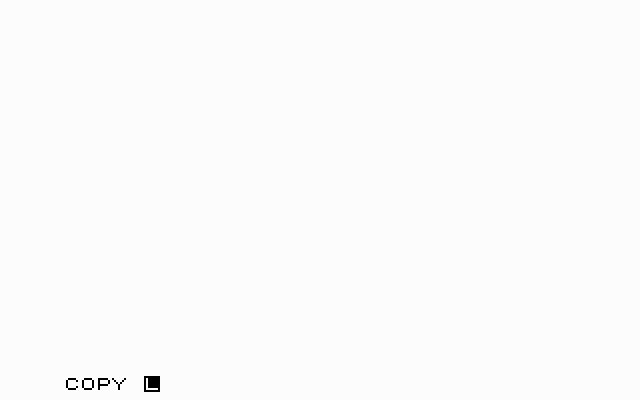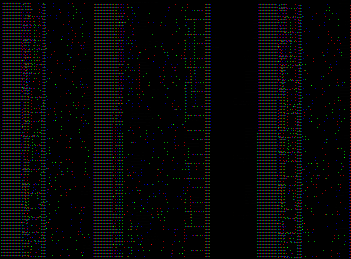GLITCH ART BLOG 10/2001 BLOG 12/2001
BLOG 11/2001
29 NOVEMBER
Ever wondered what happens when Satan possesses a Sinclair ZX Spectrum? Me too.
That reminds me - Satan is an anagram of Santa, so let me the first to wish
you all a very Happy Glitchmas.
The emulator I used to capture this was "Z80 v3.03" by G.A. Lunter.
 SATANSPECTRUMDIEDIEDIE666
24 NOVEMBER
Added new TECHNIK link to the multi-coloured Lego blocks. It's a little tutorial which
explains a bit about how I make these images.
SATANSPECTRUMDIEDIEDIE666
24 NOVEMBER
Added new TECHNIK link to the multi-coloured Lego blocks. It's a little tutorial which
explains a bit about how I make these images.
 GEESEFEEL
18 NOVEMBER
This is so deep it hurts my tiny little mind. Windows registry. Export all branches to REG.REG.
Read REG.REG into bytes and convert to pixels. Adjust ambient properties. Now it looks like wood
with a nice digital grain. BRANCHES -> WOOD. Thus I win.
GEESEFEEL
18 NOVEMBER
This is so deep it hurts my tiny little mind. Windows registry. Export all branches to REG.REG.
Read REG.REG into bytes and convert to pixels. Adjust ambient properties. Now it looks like wood
with a nice digital grain. BRANCHES -> WOOD. Thus I win.
 DISKETTEPLEASURE
16 NOVEMBER
Ugh. Been ill all week. Must consume more vegetables and whelks.
DISKETTEPLEASURE
16 NOVEMBER
Ugh. Been ill all week. Must consume more vegetables and whelks.
 SEEBOARD
11 NOVEMBER
Big prize gameshow! One prawn vindaloo for Smiley Ben for contributing some glitch
raw material. It'll arrive in the post any day now. Every glitch has a story
describing its portentious birth and this one is no different in that respect.
However, this glitch is different from the others on this site in that it
has been passed through two *analogue* stages before even reaching your VDU.
Shock, horror! But this site is about *digital* corruption, n'est-pas? Well, yes,
but a recent conversation with H. Hare about locksmiths and German analogue hacking
have made me want to explore analogue glitches too. Could be tricky, but we'll
see what develops. But I digress. Today's glitch started life as an ordinary
black-and-white text document which today's contributor wanted to print. It's a
small yet nonetheless insignificant detail that the software being used was
a multi-platform editor called AbiWord. However, selecting the black-and-white
mode in the print options produced a hardcopy consisting entirely of horizontal
stripes. Happily, selecting a colour printout reproduced the
document correctly. So, the image below is a scan of the actual, slightly crumpled,
stripey printout. I've cranked up the contrast level to make the image inhabit
the digital/analogue interface: if you hadn't just read this, would you have
known this isn't a purely digital glitch? Exactly. I'm controlling your mind, see?
SEEBOARD
11 NOVEMBER
Big prize gameshow! One prawn vindaloo for Smiley Ben for contributing some glitch
raw material. It'll arrive in the post any day now. Every glitch has a story
describing its portentious birth and this one is no different in that respect.
However, this glitch is different from the others on this site in that it
has been passed through two *analogue* stages before even reaching your VDU.
Shock, horror! But this site is about *digital* corruption, n'est-pas? Well, yes,
but a recent conversation with H. Hare about locksmiths and German analogue hacking
have made me want to explore analogue glitches too. Could be tricky, but we'll
see what develops. But I digress. Today's glitch started life as an ordinary
black-and-white text document which today's contributor wanted to print. It's a
small yet nonetheless insignificant detail that the software being used was
a multi-platform editor called AbiWord. However, selecting the black-and-white
mode in the print options produced a hardcopy consisting entirely of horizontal
stripes. Happily, selecting a colour printout reproduced the
document correctly. So, the image below is a scan of the actual, slightly crumpled,
stripey printout. I've cranked up the contrast level to make the image inhabit
the digital/analogue interface: if you hadn't just read this, would you have
known this isn't a purely digital glitch? Exactly. I'm controlling your mind, see?
 WRKSNPPR
10 NOVEMBER
This is what happens when you hit COPY on a ZX81. It goes all wobbly whilst
it says hello to the lineprinter, but then it recovers and says everything's OK.
Probably some hardware is shared by the printer and the screen refresh routine,
so it just gives up on drawing the screen.
WRKSNPPR
10 NOVEMBER
This is what happens when you hit COPY on a ZX81. It goes all wobbly whilst
it says hello to the lineprinter, but then it recovers and says everything's OK.
Probably some hardware is shared by the printer and the screen refresh routine,
so it just gives up on drawing the screen.
 CPYSCN
07 NOVEMBER
Still playing with the ZX81 emulator, I noticed a file in the emulator folder
called LPRINTER.BMP. This file gets produced from the COPY statement, which is what you
use to dump the screen to your lineprinter. I remember the official ZX81-compatible
printers - about £70 and they used very thick, shiny thermal paper which used to
fade quite quickly! I wonder if anyone's selling it on eBay... :-)
Anyway, I don't remember when I invoked COPY, but this is the LPRINTER.BMP image
I found, so it must have been on the screen at some point! It has a great sense
of perspective too - the top and bottom edges seem nearer than the middle, due
to the elongated pixels.
CPYSCN
07 NOVEMBER
Still playing with the ZX81 emulator, I noticed a file in the emulator folder
called LPRINTER.BMP. This file gets produced from the COPY statement, which is what you
use to dump the screen to your lineprinter. I remember the official ZX81-compatible
printers - about £70 and they used very thick, shiny thermal paper which used to
fade quite quickly! I wonder if anyone's selling it on eBay... :-)
Anyway, I don't remember when I invoked COPY, but this is the LPRINTER.BMP image
I found, so it must have been on the screen at some point! It has a great sense
of perspective too - the top and bottom edges seem nearer than the middle, due
to the elongated pixels.
 INTLPR
03 NOVEMBER
I'm starting this month's offerings with a slab of industrial-strength
glitch. Old enough to remember the ZX81? It's fun to POKE
random bytes all over the memory until it dies, hopefully producing
some screen-crud along the way. I used the XTender2 emulator.
The image is a straight-up screenshot. After all, the ZX81 is a strictly
black and white beast, so there aren't any colours to tweak!
INTLPR
03 NOVEMBER
I'm starting this month's offerings with a slab of industrial-strength
glitch. Old enough to remember the ZX81? It's fun to POKE
random bytes all over the memory until it dies, hopefully producing
some screen-crud along the way. I used the XTender2 emulator.
The image is a straight-up screenshot. After all, the ZX81 is a strictly
black and white beast, so there aren't any colours to tweak!
 OFFSET5STRIDE256POKE255
This is a glitch coming from some shonky interaction between XTendor2 (which is
only a beta release) and the Windows clipboard. I wanted to take a screenshot
of the emulator screen, but Windows took a garbled shot of my desktop instead, with
raster lines and mirroring effects. Anyway, I was struggling to get a pleasing
result from mucking around with this raw material, until I adjusted the contrast
curves in Photoshop, when out of nowhere this amazing matrix pattern appeared.
I've carefully tweaked the contrast to highlight the brighter pixels you can
see scattered around. I've often found that it's possible to bring out and
visually separate the layers of a glitchy image, as if you're separating the
actual processes or threads that produced the image.
OFFSET5STRIDE256POKE255
This is a glitch coming from some shonky interaction between XTendor2 (which is
only a beta release) and the Windows clipboard. I wanted to take a screenshot
of the emulator screen, but Windows took a garbled shot of my desktop instead, with
raster lines and mirroring effects. Anyway, I was struggling to get a pleasing
result from mucking around with this raw material, until I adjusted the contrast
curves in Photoshop, when out of nowhere this amazing matrix pattern appeared.
I've carefully tweaked the contrast to highlight the brighter pixels you can
see scattered around. I've often found that it's possible to bring out and
visually separate the layers of a glitchy image, as if you're separating the
actual processes or threads that produced the image.
 UNCVR
UNCVR
GLITCH ART BLOG 10/2001 BLOG 12/2001
 SATANSPECTRUMDIEDIEDIE666
24 NOVEMBER
Added new TECHNIK link to the multi-coloured Lego blocks. It's a little tutorial which
explains a bit about how I make these images.
SATANSPECTRUMDIEDIEDIE666
24 NOVEMBER
Added new TECHNIK link to the multi-coloured Lego blocks. It's a little tutorial which
explains a bit about how I make these images.
 GEESEFEEL
18 NOVEMBER
This is so deep it hurts my tiny little mind. Windows registry. Export all branches to REG.REG.
Read REG.REG into bytes and convert to pixels. Adjust ambient properties. Now it looks like wood
with a nice digital grain. BRANCHES -> WOOD. Thus I win.
GEESEFEEL
18 NOVEMBER
This is so deep it hurts my tiny little mind. Windows registry. Export all branches to REG.REG.
Read REG.REG into bytes and convert to pixels. Adjust ambient properties. Now it looks like wood
with a nice digital grain. BRANCHES -> WOOD. Thus I win.
 DISKETTEPLEASURE
16 NOVEMBER
Ugh. Been ill all week. Must consume more vegetables and whelks.
DISKETTEPLEASURE
16 NOVEMBER
Ugh. Been ill all week. Must consume more vegetables and whelks.
 SEEBOARD
11 NOVEMBER
Big prize gameshow! One prawn vindaloo for Smiley Ben for contributing some glitch
raw material. It'll arrive in the post any day now. Every glitch has a story
describing its portentious birth and this one is no different in that respect.
However, this glitch is different from the others on this site in that it
has been passed through two *analogue* stages before even reaching your VDU.
Shock, horror! But this site is about *digital* corruption, n'est-pas? Well, yes,
but a recent conversation with H. Hare about locksmiths and German analogue hacking
have made me want to explore analogue glitches too. Could be tricky, but we'll
see what develops. But I digress. Today's glitch started life as an ordinary
black-and-white text document which today's contributor wanted to print. It's a
small yet nonetheless insignificant detail that the software being used was
a multi-platform editor called AbiWord. However, selecting the black-and-white
mode in the print options produced a hardcopy consisting entirely of horizontal
stripes. Happily, selecting a colour printout reproduced the
document correctly. So, the image below is a scan of the actual, slightly crumpled,
stripey printout. I've cranked up the contrast level to make the image inhabit
the digital/analogue interface: if you hadn't just read this, would you have
known this isn't a purely digital glitch? Exactly. I'm controlling your mind, see?
SEEBOARD
11 NOVEMBER
Big prize gameshow! One prawn vindaloo for Smiley Ben for contributing some glitch
raw material. It'll arrive in the post any day now. Every glitch has a story
describing its portentious birth and this one is no different in that respect.
However, this glitch is different from the others on this site in that it
has been passed through two *analogue* stages before even reaching your VDU.
Shock, horror! But this site is about *digital* corruption, n'est-pas? Well, yes,
but a recent conversation with H. Hare about locksmiths and German analogue hacking
have made me want to explore analogue glitches too. Could be tricky, but we'll
see what develops. But I digress. Today's glitch started life as an ordinary
black-and-white text document which today's contributor wanted to print. It's a
small yet nonetheless insignificant detail that the software being used was
a multi-platform editor called AbiWord. However, selecting the black-and-white
mode in the print options produced a hardcopy consisting entirely of horizontal
stripes. Happily, selecting a colour printout reproduced the
document correctly. So, the image below is a scan of the actual, slightly crumpled,
stripey printout. I've cranked up the contrast level to make the image inhabit
the digital/analogue interface: if you hadn't just read this, would you have
known this isn't a purely digital glitch? Exactly. I'm controlling your mind, see?
 WRKSNPPR
10 NOVEMBER
This is what happens when you hit COPY on a ZX81. It goes all wobbly whilst
it says hello to the lineprinter, but then it recovers and says everything's OK.
Probably some hardware is shared by the printer and the screen refresh routine,
so it just gives up on drawing the screen.
WRKSNPPR
10 NOVEMBER
This is what happens when you hit COPY on a ZX81. It goes all wobbly whilst
it says hello to the lineprinter, but then it recovers and says everything's OK.
Probably some hardware is shared by the printer and the screen refresh routine,
so it just gives up on drawing the screen.
 CPYSCN
07 NOVEMBER
Still playing with the ZX81 emulator, I noticed a file in the emulator folder
called LPRINTER.BMP. This file gets produced from the COPY statement, which is what you
use to dump the screen to your lineprinter. I remember the official ZX81-compatible
printers - about £70 and they used very thick, shiny thermal paper which used to
fade quite quickly! I wonder if anyone's selling it on eBay... :-)
Anyway, I don't remember when I invoked COPY, but this is the LPRINTER.BMP image
I found, so it must have been on the screen at some point! It has a great sense
of perspective too - the top and bottom edges seem nearer than the middle, due
to the elongated pixels.
CPYSCN
07 NOVEMBER
Still playing with the ZX81 emulator, I noticed a file in the emulator folder
called LPRINTER.BMP. This file gets produced from the COPY statement, which is what you
use to dump the screen to your lineprinter. I remember the official ZX81-compatible
printers - about £70 and they used very thick, shiny thermal paper which used to
fade quite quickly! I wonder if anyone's selling it on eBay... :-)
Anyway, I don't remember when I invoked COPY, but this is the LPRINTER.BMP image
I found, so it must have been on the screen at some point! It has a great sense
of perspective too - the top and bottom edges seem nearer than the middle, due
to the elongated pixels.
 INTLPR
03 NOVEMBER
I'm starting this month's offerings with a slab of industrial-strength
glitch. Old enough to remember the ZX81? It's fun to POKE
random bytes all over the memory until it dies, hopefully producing
some screen-crud along the way. I used the XTender2 emulator.
The image is a straight-up screenshot. After all, the ZX81 is a strictly
black and white beast, so there aren't any colours to tweak!
INTLPR
03 NOVEMBER
I'm starting this month's offerings with a slab of industrial-strength
glitch. Old enough to remember the ZX81? It's fun to POKE
random bytes all over the memory until it dies, hopefully producing
some screen-crud along the way. I used the XTender2 emulator.
The image is a straight-up screenshot. After all, the ZX81 is a strictly
black and white beast, so there aren't any colours to tweak!
 OFFSET5STRIDE256POKE255
This is a glitch coming from some shonky interaction between XTendor2 (which is
only a beta release) and the Windows clipboard. I wanted to take a screenshot
of the emulator screen, but Windows took a garbled shot of my desktop instead, with
raster lines and mirroring effects. Anyway, I was struggling to get a pleasing
result from mucking around with this raw material, until I adjusted the contrast
curves in Photoshop, when out of nowhere this amazing matrix pattern appeared.
I've carefully tweaked the contrast to highlight the brighter pixels you can
see scattered around. I've often found that it's possible to bring out and
visually separate the layers of a glitchy image, as if you're separating the
actual processes or threads that produced the image.
OFFSET5STRIDE256POKE255
This is a glitch coming from some shonky interaction between XTendor2 (which is
only a beta release) and the Windows clipboard. I wanted to take a screenshot
of the emulator screen, but Windows took a garbled shot of my desktop instead, with
raster lines and mirroring effects. Anyway, I was struggling to get a pleasing
result from mucking around with this raw material, until I adjusted the contrast
curves in Photoshop, when out of nowhere this amazing matrix pattern appeared.
I've carefully tweaked the contrast to highlight the brighter pixels you can
see scattered around. I've often found that it's possible to bring out and
visually separate the layers of a glitchy image, as if you're separating the
actual processes or threads that produced the image.
 UNCVR
UNCVR